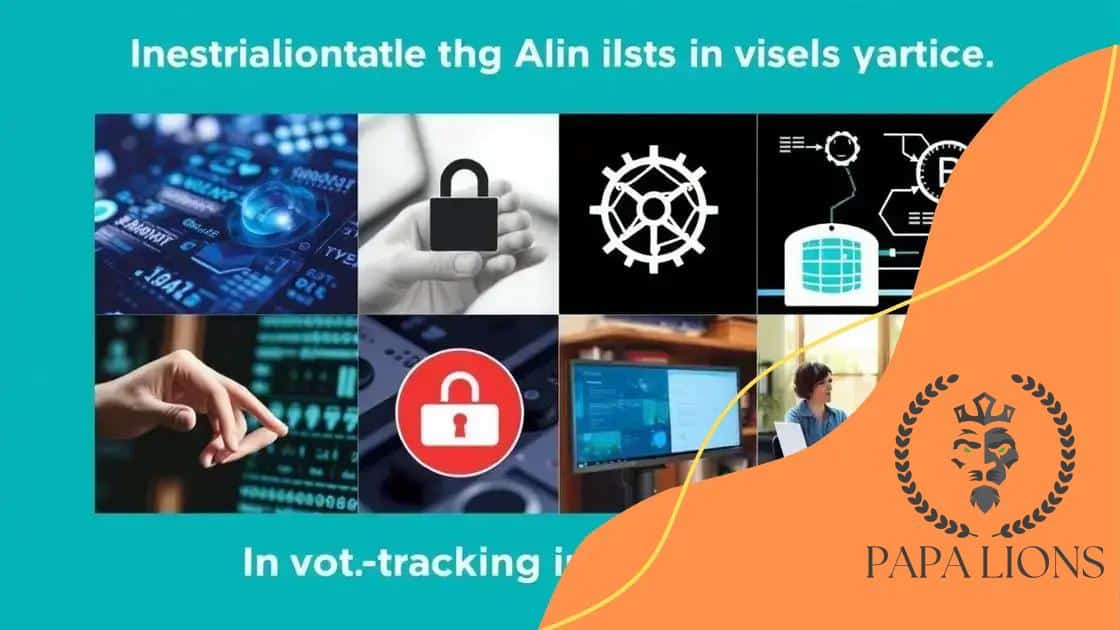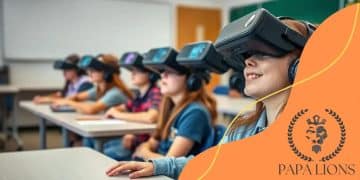AI tracking student engagement: boosting learning outcomes

AI tracking student engagement enhances learning by personalizing education, providing real-time feedback, and utilizing data analytics to improve instructional strategies in the classroom.
AI tracking student engagement is a transformative tool for educators looking to enhance classroom interaction. Have you ever wondered how technology can boost learning results? Let’s dive into how AI is shaping the future of education.
Understanding AI tracking technology
Understanding AI tracking technology is essential for educators looking to enhance student engagement. This technology helps in monitoring how students interact with learning materials, allowing teachers to adapt their approaches accordingly.
AI tools can collect data on student performance, participation, and even emotional responses. By analyzing this data, schools can gain valuable insights into student behaviors. This not only helps in assessing individual progress but also in identifying trends across classrooms.
Key Features of AI Tracking
Some important features of AI tracking technology include:
- Real-time data collection on student activities.
- Personalized learning paths based on student needs.
- Automatic feedback loops to inform teachers immediately.
This immediate feedback can empower educators to make swift changes, enhancing the overall learning experience. Additionally, the integration of AI monitoring systems can promote a more engaging classroom atmosphere.
Imagine a classroom where each student’s needs are met in real-time! This adaptability can reduce frustration for students struggling with material, helping them stay engaged and motivated. Furthermore, teachers can focus on intervention strategies where they are most needed.
How AI Tracking Works
AI tracking employs advanced algorithms to analyze data from student interactions with educational tools. This data can come from:
- Online quizzes and assessments.
- Engagement with multimedia content.
- Classroom participation metrics.
By leveraging these metrics, educators can design lessons that cater to the specific needs of their students. For instance, if the tracking shows that many students are struggling with a particular concept, a teacher can revisit the material in a new way.
In summary, understanding AI tracking technology is vital for maximizing educational outcomes. By utilizing data-driven insights, schools can foster a more inclusive and effective learning environment.
Key benefits of AI in student engagement
The key benefits of AI in student engagement are transforming classrooms across the globe. By harnessing technology, educators can create more interactive and motivating learning experiences for their students.
One major advantage of AI is its ability to provide personalized learning paths. Each student has unique learning needs, and AI can help tailor educational content to meet those needs. This means that struggling students receive extra help, while advanced learners can be challenged appropriately.
Benefits of AI in Enhancing Learning
Some specific benefits of utilizing AI for student engagement include:
- Timely feedback that helps both students and teachers adjust their strategies.
- Interactive learning tools that make lessons more engaging.
- Automated administrative tasks, allowing teachers to focus more on teaching.
Moreover, AI systems can analyze data from student interactions to identify patterns. These patterns help educators understand which teaching methods are most effective. For example, if a majority of students excel after group discussions, teachers can integrate more collaborative activities into their curriculum.
Enhanced Accessibility
AI technology also improves accessibility for students with learning disabilities. Special tools can assist these students in overcoming challenges, ensuring they are part of the learning community. This pushes the boundaries of inclusivity, allowing all students to thrive.
Additionally, AI can help facilitate communication between students and teachers. Intelligent systems can remind students about deadlines and assignments, and provide quick answers to common questions. This fosters a supportive and informed learning environment.
In summary, incorporating AI in student engagement transforms how education is experienced. By embracing these technologies, schools can create dynamic and fulfilling educational landscapes that inspire students to learn.
Challenges of implementing AI tracking

Implementing AI tracking in educational settings comes with several challenges. While the potential benefits are significant, schools must navigate various hurdles before fully integrating these technologies.
One of the primary challenges is the cost of technology. Many schools struggle to find the necessary funds to invest in AI systems. This can limit access to quality tools that enhance student engagement. Additionally, maintenance and updates can be expensive, putting further strain on budgets.
Data Privacy Concerns
Data privacy is another critical concern. Schools collect vast amounts of information on their students, and ensuring this data remains secure is paramount. Parents and educators must have assurances that student data will not be misused or exposed to breaches.
- Creating secure systems to store sensitive information.
- Maintaining transparency about how data is used.
- Complying with regulations such as FERPA and GDPR.
Moreover, the implementation of AI tracking requires adequate training for teachers and staff. Many educators may feel overwhelmed by new technology. As a result, proper training sessions are essential to help them understand and utilize these systems effectively. With comprehensive training, teachers can feel more confident and competent in employing AI tools.
Integration with Existing Systems
Integrating new AI systems with existing educational apps can be complicated. In some cases, these systems may not be compatible, leading to frustration for both teachers and students. Technical support is vital in these scenarios to troubleshoot issues as they arise.
Finally, gaining buy-in from all stakeholders is necessary for successful implementation. This includes students, parents, and school leaders. When everyone understands the benefits of AI tracking, it can foster a more collaborative environment. As schools work through these challenges, the potential for enhanced student engagement remains within reach.
Real-world examples of AI in education
Real-world examples of AI in education showcase how this technology is transforming learning environments. Various schools and organizations are adopting AI solutions to enhance student engagement and improve educational outcomes.
One notable example is the use of AI tutoring systems like Carnegie Learning. This platform tailors math instruction to individual student needs. By analyzing performance data, it adapts lessons in real-time, helping students grasp challenging concepts more effectively.
AI-Powered Learning Tools
Another example is the use of chatbots in educational settings. Many universities have implemented chatbots to assist students with common inquiries, such as admission processes and course details. These chatbots are available 24/7, making information more accessible.
- Improved response times for student queries.
- Personalized support for course selections.
- Enhanced engagement through interactive conversations.
AI analytics are also being used by schools to track academic performance. For instance, platforms like BrightBytes provide data-driven insights. They can help educators understand which teaching methods are most effective based on student performance metrics, guiding instructional decisions.
Innovative Learning Environments
Furthermore, AI is significantly impacting special education. Programs such as speech recognition software assist students with speech disabilities. These tools help them communicate effectively, fostering inclusion and participation in the classroom.
The integration of AI technology extends beyond traditional classrooms. Online learning platforms like Coursera and edX use AI to recommend courses based on user interests and previous engagements. This ensures that each learner receives personalized suggestions that align with their learning journeys.
Overall, real-world examples of AI in education illustrate its potential to enhance engagement and improve learning outcomes. As more schools implement these technologies, the educational landscape will continue to evolve positively.
Future trends in AI and student engagement
Future trends in AI and student engagement promise exciting developments in education. As technology advances, it will continue to shape how students learn and interact in the classroom.
One major trend is the growing use of adaptive learning systems. These systems tailor educational content to each student’s learning style and pace. By harnessing data analytics, they can provide personalized experiences that keep students more engaged.
Increased Use of Data Analytics
Data analytics will play a crucial role in understanding student behavior. Educators will gain insights into which teaching methods are most effective. This will allow teachers to make informed decisions and adjust their strategies to better support student learning.
- Enhanced understanding of student learning patterns.
- Optimized teaching strategies based on real-time data.
- Improved student outcomes through targeted interventions.
Moreover, virtual reality (VR) and augmented reality (AR) technologies are expected to enhance engagement further. These immersive experiences can bring learning to life, allowing students to explore complex concepts in interactive ways. For example, using VR to conduct virtual field trips can make subjects like history and science come alive for students.
Collaborative Learning Experiences
Another key trend is the rise of collaborative learning platforms powered by AI. These platforms facilitate teamwork and interaction among students, fostering a sense of community. AI can help group students based on shared interests and skills, leading to more productive collaborations.
Finally, as AI continues to evolve, ethical considerations regarding student data will become increasingly important. Educators and policymakers will need to ensure that student privacy is protected while leveraging AI technologies. Striking a balance between innovation and ethics will be crucial in realizing the full potential of AI in education.
With these advancements on the horizon, the future of AI and student engagement looks bright. Students will benefit from more personalized, interactive, and effective learning environments.
In conclusion, the integration of AI in education presents a remarkable opportunity to enhance student engagement and improve learning outcomes. As we move into the future, adaptive learning systems, data analytics, and immersive technologies like VR and AR will play pivotal roles. However, along with these advancements come challenges, such as data privacy and the need for teacher training. By embracing these technologies wisely, we can create more personalized, interactive, and effective learning environments for all students, fostering a love for learning that lasts a lifetime.
FAQ – Frequently Asked Questions about AI in Education
How does AI improve student engagement?
AI enhances student engagement by providing personalized learning experiences, immediate feedback, and interactive tools that cater to individual learning styles.
What are some challenges schools face when implementing AI?
Challenges include the cost of technology, data privacy concerns, the need for teacher training, and integration with existing systems.
Can AI help teachers analyze student performance?
Yes, AI tools can analyze large amounts of data, providing teachers with insights into student performance that help improve teaching strategies.
What are the future trends of AI in education?
Future trends include increased use of adaptive learning systems, data analytics for performance tracking, and the incorporation of VR and AR technologies to enhance learning.





